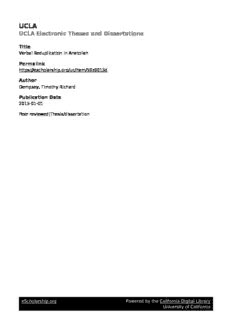
Verbal Reduplication in Anatolian PDF
Preview Verbal Reduplication in Anatolian
UCLA UCLA Electronic Theses and Dissertations Title Verbal Reduplication in Anatolian Permalink https://escholarship.org/uc/item/50z0015d Author Dempsey, Timothy Richard Publication Date 2015 Peer reviewed|Thesis/dissertation eScholarship.org Powered by the California Digital Library University of California UNIVERSITY OF CALIFORNIA Los Angeles Verbal Reduplication in Anatolian A dissertation submitted in partial satisfaction of the requirements for the degree Doctor of Philosophy in Indo-European Studies by Timothy Richard Dempsey 2015 ABSTRACT OF THE DISSERTATION Verbal Reduplication in Anatolian by Timothy Richard Dempsey Doctor of Philosophy in Indo-European Studies University of California, Los Angeles, 2015 Professor H. Craig Melchert, Chair Scholars have long suspected that the verbal reduplication patterns reflected in the Anatolian languages encode typologically expected imperfectivity and iconic expressivism. At the same time, Indo-Europeanists have looked to the Anatolian languages for relics of archaic reduplicated categories of marked semantics and shape. This dissertation provides a comprehensive examination of the forms and functions of the various Anatolian reduplicated verbs attested in the Hittite, Luvian, and Lycian languages. Following a typological survey to establish what exactly the “expected” semantics of reduplication in a verb are, the study then provides sketches for the semantics of all known Hittite, Luvian, and Lycian reduplicated verbs ii of sufficient attestation to do so. I then examine the formal history of all attested Anatolian reduplicated verbs, projecting their preforms as far back as able, and divide them according to their reduplicative patterns, commenting on the relative productivity of each. In the end, typologically trivial partial copy vowel reduplication proves to be the most productive pattern of verbal reduplication in the Anatolian languages, commonly used with habitual, durative, iterative, and other universally expected imperfective nuances. The same semantics obtain in the more marginal but also productive /i/-reduplication, a formal pattern inherited from Proto- Indo-European. Similarly inherited /e/-reduplication persists in some forms, with the same semantics seen in other partial reduplicative patterns in Anatolian. The majority of “expressive” reduplicated verbs are unpaired synchronically with a base stem, and frequently show full root reduplication. There are a handful of “intensive” reduplicated verbs with full root reduplication and a “linking” /i/, which may or may not be parallel to Vedic intensives of similar shape. The evidence overwhelmingly proves that the accent was firmly on the reduplicant in every category. A number of interesting facts emerge in the exploration of the Anatolian data. We see perhaps the emergence of new reduplicative categories in Hittite asās- / ases- and Lycian ppuwe-, while the distribution of Anatolian /i/-reduplication and the phonological history of /e/-reduplication has implications for the reconstruction of the Proto-Indo-European verbal system. iii The dissertation of Timothy R. Dempsey is approved. Stephanie J. Watkins Brent H. Vine Vyacheslav Ivanov H. Craig Melchert, Committee Chair University of California, Los Angeles 2015 iv To my grandparents, Jim and Ida, whose love of learning lives on in their family. v Table of Contents Chapter 1. Introduction 1.1. Goals and Organization 1.2. Establishing Terminology 1.3. The Proto-Indo-European Context 1.3.1. PIE Verbal Categories 1.3.2. The PIE Perfect and Anatolian 1.3.3. Reconciling PIE /i/- and /e/-reduplicating Presents Chapter 2. The Typology of Verbal Reduplication 2.1. Preliminary Remarks The Universal Typology of Verbal Reduplication: 2.2. The Semantics of Reduplicated Verbs: A Brief Survey 2.3. Cases of the Expected Iconicity/Pluractionality of Reduplication in the Verb 2.3.1.+ Case Studies 2.4. Unexpected or Less Transparently Iconic Instances of Verbal Reduplication 2.4.1.+ Case Studies 2.5. The Reduplicant’s Shape: Possible Connections in Form to Function? vi 2.5.1.+ Types of Reduplication, Their Functions and Shapes The Areal Typology of Verbal Reduplication: 2.6. The Semantics of Ancient Near Eastern Verbal Reduplication 2.6.1. Akkadian (Old Babylonian) 2.6.2. Hattic 2.6.3. Hurrian 2.6.4. Egyptian (Old Egyptian and Coptic) 2.6.5. Areal Summary Chapter 3. Reduplicated Verbs in Hittite Part 1: Paired Synchronic Stems 3. Preliminary Remarks 3.1.+ Individual Stem Studies 3.23. Hittite Reduplicative Semantics Thus Far Chapter 4. Reduplicated Verbs in Hittite Part 2: Unpaired Verbal Stems (and Some Denominatives) 4. Preliminary Remarks 4.1.+ Individual Stem Studies 4.23. Summary of the Semantics of Hittite Unpaired Reduplicated Stems vii Chapter 5. The Reduplicated Verb in Luvo-Lycian 5. Preliminary Remarks 5.1. Luvian 5.1.1.+ Individual Stem Studies 5.1.14. Miscellany 5.2. Lycian 5.2.1. pije- “to give” 5.2.2. Miscellany 5.3. Concluding Remarks Chapter 6. Reconstructing the Anatolian Reduplicated Verb 6.1. Organizational and Operational Principles; Preliminary Conclusions 6.2. Homovocalic Reduplication 6.2.1.+ Individual Stem Studies 6.2.29. Miscellany 6.3. Heterovocalic Reduplication 6.3.1.+ Individual Stem Studies 6.4. /i/-Reduplication (Cí-CC-) viii
